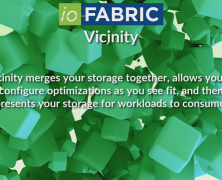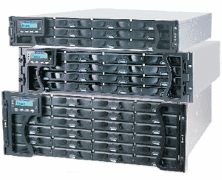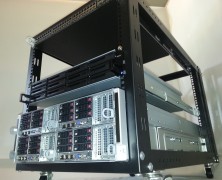It’s that time of year again. The time of year where I thank vendors for sucking slightly less than their competitors over the previous 12 months. Some do this through product excellence, some through excellence in customer service. As a rule, I find vendors trying, and so I take an almost absurd amount of pleasure in reminiscing on those that, in one form or another, make the grade. To this end, I will start the year’s festivities with a joke about how to define how “ready” a product is for general consumption. Google ready: 4 years, 3 PhDs and an army of undergrads later it runs in 30 datacenters on 5 continents, but only two people know how. Hyperscale ready: with a trained $1M/yr specialist and a support team of 5 it will support 50,000 clients at 99.95% uptime. Enterprise ready: with a team of 20 certified technicians, 4 middle managers and a vendor engineer it will integrate with our mainframe. SMB ready: one of the two burnt out husks that were people remembers enough about how it works to restart it. Trevor Pott ready: issues reduced to one 4:00am phone call per annum. So without further delay, here is my totally biased list of 2016’s kickass vendors that have made my own personal life easier: Scale Computing Scale Computing make hyperconverged appliances. Servers (3 or more) with built-in storage that work together to allow virtualized workloads to achieve high availability without needing a SAN. Scale’s solution is built on top of KVM and uses their own custom software for monitoring, self-healing, management and a user interface. Scale doesn’t expose nearly as many of the hypervisor’s features to the user as rivals like VMware. From one perspective, this means that Scale is nowhere near...
ioFABRIC Vicinity 1.7 Video Review
posted by Josh Folland
ioFABRIC provided us with access to their software-defined storage platform, Vicinity (version 1.7) and commissioned us to do a review. The short version? It’s good. VERY Good. ioFABRIC Vicinity merges all of your storage together and presents it as a single storage fabric for your workloads to consume, all while allowing you to configure optimizations to ensure the right workloads are using the right storage – fast, high IOPS workloads on fast, high IOPS storage; and slow, low IOPS workloads on slow, low IOPS storage. It deploys either onto bare metal or as a virtual appliance and can be installed and configured in minutes. In our review video, we explain how ioFABRIC Vicinity works, why it’s different from other software-defined storage platforms out there, and show how it’s transformed our data center. Check out the video below and be sure to visit ioFABRIC.com/deploy to try it out for...
Beyond the traditional storage gateway
posted by Trevor Pott
Bringing together all storage into a single point of management, wherever it resides, has long been a dream for storage administrators. Many attempts have been made to make this possible, but each has in some way fallen short. Some of the problem is that previous vendors just haven’t dreamed big enough. A traditional storage gateway is designed to take multiple existing storage devices and present them as a single whole. Given that storage gateways are a (relatively) new concept, all too often the only storage devices supported would be enterprise favourites, such as EMC and NetApp. Startups love to target only the enterprise. Around the same time as storage gateways started emerging, however, the storage landscape exploded. EMC, Netapp, Dell, HP, and IBM slowly lost market share to the ominous “other” category. Facebook and other hyperscale giants popularized the idea of whitebox storage and shortly thereafter Supermicro became a $2 Billion per year company. As hyperscale talent and experience expanded more and more, public cloud storage providers started showing up. Suddenly a storage gateway that served as a means to move workloads between EMC and Netapp, or to bypass the exorbitant prices those companies charged for certain features just wasn’t good enough. Trying to force a marriage between different storage devices on a case-by-case basis isn’t sustainable. Even after the current proliferation of storage startups comes to an end, and the inevitable contraction occurs, there will still be dozens of viable midmarket and higher storage players with hundreds of products between them. No company – startup or not – can possibly hope to code specifically for all of them. Even if, by some miracle, a storage gateway taking this boil-the-ocean approach did manage to bring all relevant storage into their offering one product at a...
Data residency made easy
posted by Trevor Pott
Where does your data live? For most organizations, data locality is as simple as making sure that the data is close to where it is being used. For some, data locality must also factor in geographical location and/or legal description. Regardless of the scope, data locality is a real world concern to an increasing number of organizations. If this is the first time you are encountering the term data locality you are likely asking yourself – quite reasonably – “do I care?” and “should I care?” For a lot of smaller organizations that don’t use public cloud computing or storage, the answer is likely no. Smaller organizations using on-premises IT likely aren’t using storage at scale or doing anything particularly fancy. By default, the storage small IT shops use lives with the workload that uses it. So far so good… except the number of organizations that fall into this category is shrinking rapidly. It is increasingly hard to find someone not using public cloud computing to some extent. Individuals as well as organizations use it for everything from hosted email to Dropbox-like storage to line-of-business applications and more. For the individual, cost and convenience are usually the only considerations. Things get murkier for organizations. The murky legal stuff Whether you run a business, government department, not-for-profit, or other type of organization, at some point you take in customer data. This data can be as simple as name, phone number, and address. It could also be confidential information shared between business partners, credit card information, or other sensitive data. Most organizations in most jurisdictions have a legal duty of care towards customers that requires their data be protected. Some jurisdictions are laxer than others, and some are more stringent with their requirements based on the...




